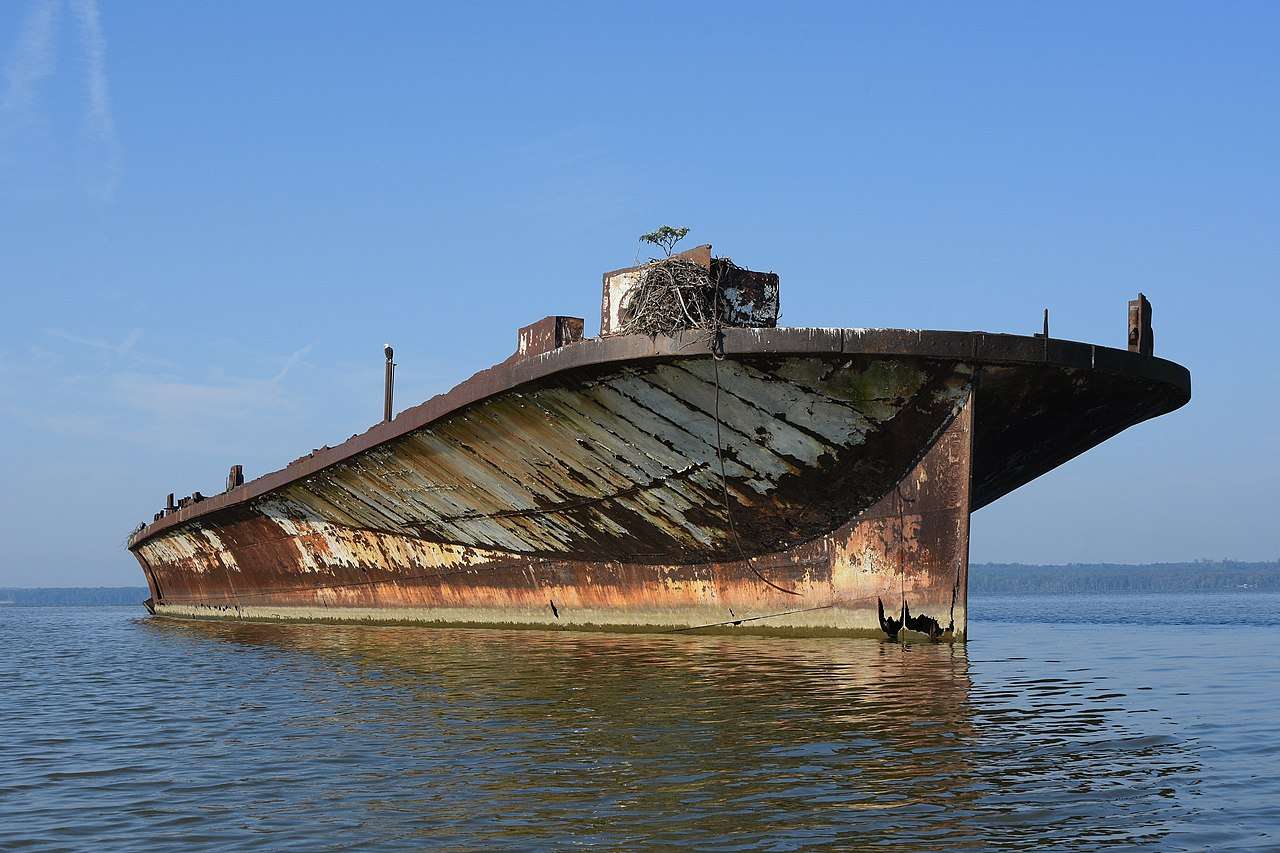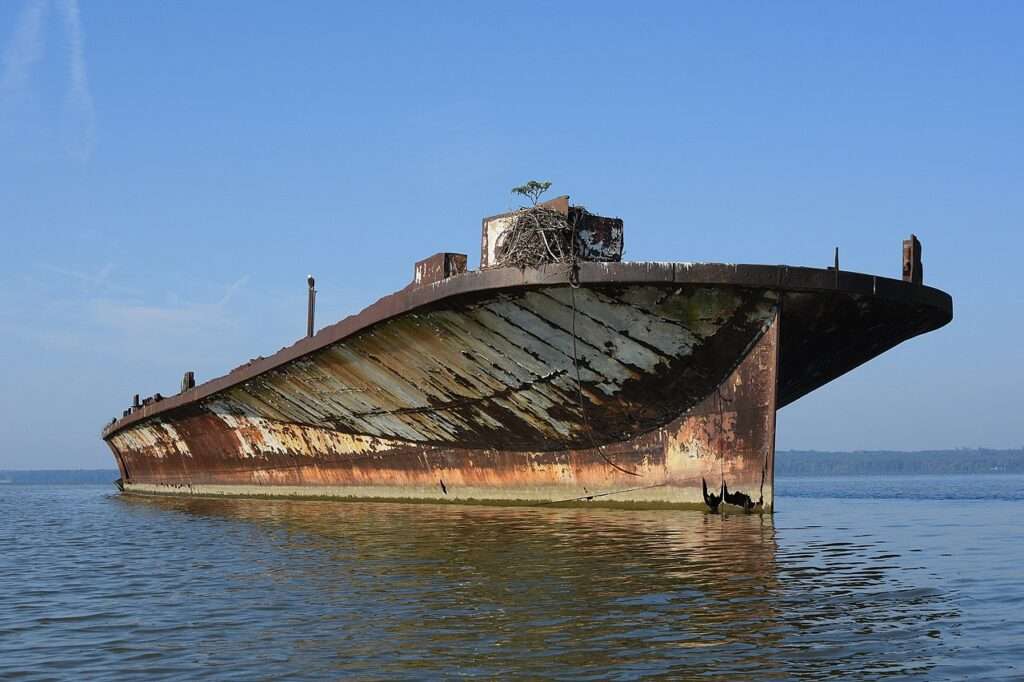Located along the tidal flats of the Potomac River in Maryland, the Ghost Fleet of Mallows Bay offers an uncanny testament to a bygone era in American history.

Home to the largest shipwreck fleet in the Western Hemisphere, Mallows Bay contains over 200 sunken vessels, most of which date back to World War I.
This compelling relic of history, which has been declared a National Marine Sanctuary, serves as an intriguing record of maritime technology, environmental conservation, and the urgent economic demands of wartime.
History Of The Fleet
The story of Mallows Bay began during World War I when the United States, caught off guard by Germany’s unrestricted submarine warfare, sought to counteract this threat through an ambitious shipbuilding program.
This program aimed to construct a thousand wooden steamships within 18 months to ensure that supplies and troops reached European allies without disruption.
 An aerial photograph from 1936 showing just how many ships make up the ‘Ghost Fleet’
An aerial photograph from 1936 showing just how many ships make up the ‘Ghost Fleet’
Unfortunately, the undertaking was marred by setbacks, with the war ending before most of these vessels could be completed or deployed.
This led to the incomplete or barely used vessels being deemed surplus and scuttled in places like Mallows Bay, thereby creating the “ghost fleet.”
The term “Ghost Fleet” of Mallows Bay pertains to the remnants of numerous ships that are settled in its moderately shallow waters.
In essence, 230 vessels from the United States Shipping Board Merchant Fleet Corporation were sunk in the river.
Over 100 of these ships are wooden steamships, which were a part of a massive fleet designed to traverse the Atlantic during World War I.
Owing to a scarcity of steel, these ships were constructed out of wood, which rendered them outdated shortly after their completion when the war ended.
The U.S. Navy showed no interest in these ships, which had been stored in the James River at an expense of $50,000 monthly.
 One of the wrecks at Mallows Bay. Image by Amaury Laporte CC BY 2.0
One of the wrecks at Mallows Bay. Image by Amaury Laporte CC BY 2.0
Consequently, the ships were sold to the Western Marine & Salvage Company.
This company relocated the ships to the Potomac River at Widewater, Virginia, and in 1925, the fleet was towed to Mallows Bay.
Western Marine, however, declared bankruptcy and the ships, left to their fate, were set on fire and left where they sank.
During the course of World War II, Bethlehem Steel constructed a salvage basin to extract metal from these abandoned ships.
The site is also the final resting place for the wreckage of various civilian vessels.
Present Day
The years following World War I have seen the Ghost Fleet of Mallows Bay gradually transforming from a graveyard of abandoned vessels into a vibrant and biodiverse marine habitat.
The hulls of these decaying vessels now provide a unique ecosystem for a variety of species.
 Image by Amaury Laporte CC BY 2.0
Image by Amaury Laporte CC BY 2.0
Over time, trees, bushes, and other flora have taken root in the wooden wrecks, while the underwater portions serve as a refuge for fish, beavers, and birds.
Thus, what was once viewed as a colossal waste has, over the past century, become a valuable ecological resource, embodying the principle of nature reclaiming man-made waste.
Apart from its ecological value, Mallows Bay holds great historical and archaeological significance.
Each shipwreck is a snapshot of the past, capturing the distinctive shipbuilding techniques of the early 20th century.
Amateur and professional historians alike have used these vessels as primary sources to understand maritime history.
 Image by Amaury Laporte CC BY 2.0
Image by Amaury Laporte CC BY 2.0
Recent years have seen recognition of the Ghost Fleet’s unique status.
In 2019, the National Oceanic and Atmospheric Administration (NOAA) designated Mallows Bay-Potomac River as a National Marine Sanctuary due to its ecological, recreational, and historical significance.
This protection has allowed for the preservation and study of these remnants of history while promoting public engagement through tourism and educational programs.
Legacy Of The Ghost Fleet
The Ghost Fleet of Mallows Bay is more than just a cluster of shipwrecks.
It’s a testament to a troubled period in American history, a living laboratory of maritime archaeology, a flourishing ecological habitat, and a symbolic monument to the transformative powers of time and nature.
 The outline of one of the wooden steamships that was set ablaze. Image by Amaury Laporte CC BY 2.0
The outline of one of the wooden steamships that was set ablaze. Image by Amaury Laporte CC BY 2.0
This unique amalgamation of history and nature underscores the importance of preserving such sites, not only as a remembrance of the past but as a testament to nature’s resilience and enduring capacity for renewal.





